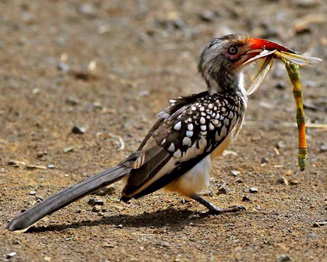
Tockus erythrorhynchus
SUBFAMILY
Bucerotinae
TAXONOMY
Buceros erythrorhynchus Temminck, 1823, Podor, Senegal. Four
subspecies.
OTHER COMMON NAMES
English: African red-billed hornbill, South African red-billed
hornbill, Damaraland red-billed hornbill; French: Calao а bec
rouge; German: Rotschnabeltoko; Spanish: Toco Piquirorojo.
PHYSICAL CHARACTERISTICS
13.8 in (35 cm); female 0.2–0.44 lb (90–200 g), male 0.27–0.48
lb (124–220 g). Small, black and white with spotted wing
coverts; long slender red bill with small casque.
DISTRIBUTION
T. e. erythrorhynchus: Niger Delta to Ethiopia and Somalia,
south to Tanzania; T. e. kempi: Southern Mauritania, Senegal
to Niger Delta; T. e. rufirostris: Southern Angola, northern
Namibia, Zambia, southern Malawi and northeastern South
Africa; T. e. damarensis: Northwestern and central Namibia.
HABITAT
Open savannas, woodland, and dry thorn-scrub.
BEHAVIOR
Territorial, maintaining boundaries by calling and displaying
on conspicuous perch early morning.
FEEDING ECOLOGY AND DIET
Active forager. Commonly joins other birds when feeding.
REPRODUCTIVE BIOLOGY
Lays two to seven eggs one to two months after start of rains.
Incubation 23–25 days; fledging 39–50 days and female
emerges with first fledgling. Remaining chicks reseal the nest
cavity using their own droppings and undigested food. Nesting
success ranged from 90% to 94% in Transvaal and Kenya, respectively
but overall productivity is around 1.5 chicks.
CONSERVATION STATUS
Not threatened. Widespread and common, mixing well with
domestic stock on open range as long as sufficient nest trees
available.
SIGNIFICANCE TO HUMANS
None known.
Photo Gallery of - Red-billed hornbill




 Animalia Life
Animalia Life